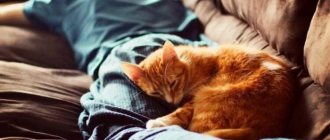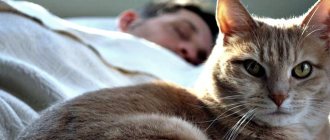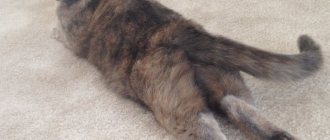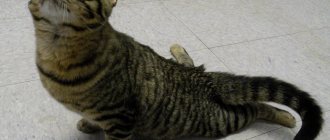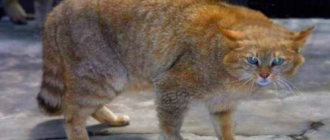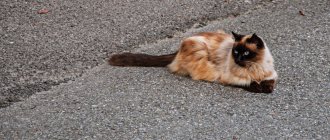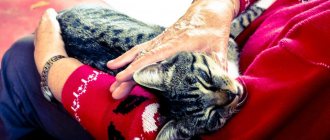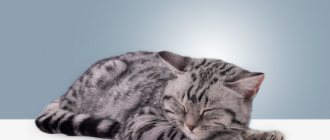It is impossible to resist the charm of a pet when it rolls over on its back and looks at you with big, soulful eyes. What could be cuter than his fluffy belly? It seems that this pose was given to the cat by nature specifically in order to make a person admire and be touched.
After taking a photo of your adorable pet and reaching out to pet its belly, you suddenly find its teeth and claws digging into your hand. A second - and the cute fluffy turns into a wild cat. Such rapid changes in the behavior of the animal cause bewilderment among their owners.
The motives that cause a cat to roll over are different. Knowing them, you can predict its reaction to human affection - whether the animal will receive pleasure or respond with aggression. Below are reasons why your pet may lie on its back. By studying them, misunderstandings can be prevented.
Pose of trust
The abdomen is one of the most sensitive parts of a cat's body, where most of the vital organs are located. Therefore, in times of danger, the animal will primarily protect this area and head.
A pet lying on its back, exposing its belly, demonstrates submission and trust. Signs of insecurity also include splayed hind legs, a relaxed tail, and a calm gaze. In this state, the cat may begin to purr, and it will not nervously twitch its tail or run away when trying to pet it.
Adopting a vulnerable position means that the animal feels that there is no threat and gives the owner access to its belly, including for stroking. At this time, it is important to assess the condition of your pet. Calmness after touching is a good sign that can be seen as an invitation to further communication. To justify the trust placed in you, you should interact with your furry friend gently and carefully.
When to worry
Aggressive cat: main causes and solution to the problem
Sometimes sleeping on its back causes the animal to spread its legs wide. Sometimes this is a sign of a serious pathology. A visit to the veterinarian and diagnostic testing are recommended for pets with the following symptoms:
- unreasonable anxiety, increased irritability;
- searching for secluded places or demonstratively drawing attention to one’s own person;
- frequent and loud meowing in an unusual tone;
- refusal to eat or independently reducing portions to minimum sizes;
- frequent trips to the toilet to empty the bowels or bladder;
- prolonged absence of urination or bowel movements;
- elevated temperatures.
Frequent trips to the toilet are the first sign that something is wrong with the animal.
Apathy and indifference to external stimuli are dangerous signs that indicate the active activity of pathogenic microflora in the body of cats. In some cases, the problem is associated with helminths and intoxication of the body from their waste products.
Possible diseases
There are a number of pathologies that lead to unusual postures in animals. Common diseases:
- poor functioning of the digestive tract - allergic reactions to cheap food, poisoning with stale food, foreign objects entering the gastrointestinal tract, intestinal parasites can cause pain in the gastrointestinal tract. Diseases may be accompanied by attacks of vomiting and diarrhea;
- diseases of the genitourinary tract. Inflammatory processes lead to problems with the free release of the bladder, the appearance of particles of blood, pus, and sand in the urine. The cat is lethargic, when urinating he has a forced, tense posture, he often twitches his hind legs, trying to facilitate the process;
- Heart diseases appear when affected by a viral or fungal infection, poisoning with salts of heavy metals, in stressful situations, and with anemia of various origins. The problem can be identified by heavy breathing with whistling, severe shortness of breath with minimal physical exertion, a drop in temperature, and pallor of the visible mucous membranes. There is no cough due to cardiac pathologies;
- neoplasms are tumors in internal organs and mammary glands, which can be of malignant or benign origin. Their gradual growth interferes with the full functioning of the digestive tract and forces cats to take a forced position on their back. Animals quickly lose weight, become apathetic, refuse to contact people, an enlarged formation on the mammary glands forces the pet to spread its paws wide, as it interferes with normal walking.
If the above signs appear, there is no need to self-medicate and diagnose your sick pet. Attempts to palpate the abdomen will lead to severe aggression with scratching and biting. Diagnostics in a veterinary clinic will help to recognize the ongoing pathological process and find the best method of therapy.
Evil intent
Sometimes a cat is forced to lie on its back by “insidious thoughts.” A sudden jump to the floor can signal that the animal is angry, so before approaching, you should try to read what her body is “saying.”
The tail is a reliable indicator of a cat's mood. Quick movements from side to side signal an increased level of activity: it is time for play (but not for petting). Some pets manage to place their tail between their paws and on their stomach to use it as a built-in toy.
A cat's eyes can tell a lot about the mood of the owner . A glittering gaze following your every move indicates that you have become a target. At this time, the cat's paws begin to twitch and you can see how the animal tries to make several tentative movements towards the intended prey. Active behavior is accompanied by purring or a series of short sounds - this is how the cat lures you.
You should avoid touching an animal lying on its back and intending to play. It is better to postpone attempts to scratch the tummy until later, and instead bring a toy (a stick or a soft object) and, after teasing your pet, watch how he playfully releases his claws.
Live alarm clock
Pets that live with one owner for a long time get used to the rhythm of human life. Often after a hard day at work, when you go to bed late, you can fall asleep so soundly that you won’t wake up from the sound of the alarm clock. An animal that is accustomed to waking up at a certain time will try in every possible way to wake up its owner. For this purpose, cats purr, lick their hands, face, and try to pull off the blanket
After repeated attempts by the animal to attract attention, you will have to stand up
It is worth considering that sleeping next to an animal may be unsafe, especially when the animal is walking outside. To avoid unpleasant moments, before the animal tries to get into bed with its owner, you need to wash its paws. Animals that have taken a fancy to their owner's bed must be treated for skin and intestinal parasites. If you suffer from allergies, carry out regular grooming of your pet, combing
Be wary of animals wanting to sleep near small children
Relaxation
Each member of the cat family has a favorite sleeping position. Some people prefer to curl up into a ball, while others prefer to stretch out on their sides. There are individuals for whom there is nothing more relaxing than lying on their back.
Sometimes cats fall asleep on their side, and when an “unconscious” state occurs, they roll over onto their back. It happens the other way around: while resting in a belly-up position, the animals feel so good that they begin to doze off. No matter when your furry friend ends up on his back, this position always causes affection.
It is usually quite easy to understand that your pet is resting while lying on its back: its paws are relaxed, its eyes are closed, its breathing is slow, and you can even hear quiet snoring.
Trying to wake a cat often provokes an aggressive reaction, even if it is resting in a protected position. Being in a vulnerable position (with its belly exposed), the animal will wake up and begin to defend itself. It is better not to disturb a pet sleeping on its back at all, but to postpone communication until it wakes up.
What does it mean if a cat sleeps on its back?
A cat's tummy is the most vulnerable and sensitively protected part of the body. Mustached pets avoid his stroking at the level of reflexes, so a very small part of them do not resist the caresses of their owner.
After falling asleep, defenselessness increases. Knowing this, the animals arrange themselves in a ball or “loaf” in advance, minimizing the number of zones for a possible attack. But there are exceptions due to one of the reasons listed below.
INTERESTING!
Cats spend most of their time “recharging” in a state of dozing, immediately reacting to any suspicious rustle.
Trusts
In safe conditions, mustachioed pets instinctively roll over onto their backs out of simple convenience. The love for this position comes from childhood, when a mother cat would turn her babies over and lick their bellies before bed. Such washing not only stimulated intestinal motility, but also relaxed.
If your pet often falls asleep in a similar position next to you, then he trusts you infinitely and is not afraid of a sudden attack. It's not easy to earn this attitude, so you can be proud of yourself.
He's feeling hot
Another reason is high room temperature. An open belly and legs spread out to the sides speed up the cooling process.
In hot weather, animals try to sleep on tiles or the ground. Their breathing rate also increases, because the evaporation of saliva contributes to a faster decrease in body temperature.
Like humans, cats have sweat glands in completely hairless or almost hairless areas. The catch is that there are only 2 of them: the muzzle and the paw pads. Because of this, wet prints often appear on the floor in hot weather.
INTERESTING!
Thick fur impairs natural cooling. Because of this, cats with long hair and dense undercoat most often roll over onto their back.
Relieves pain
In case of health problems, the sleep position in question becomes forced. It relieves discomfort in the following conditions:
- arthritis (pressure on the paws decreases);
- headaches (blood flow to the brain is normalized by stretching the spine in a straight line);
- diseases of the gastrointestinal tract and banal overeating (the load on the stomach decreases).
If the reason lies in stomach pain, then any touch for the purpose of inspection can result in aggression on the part of the disturbed animal. In this case, you should contact your veterinarian.
Ready for love
When a female lays on her back during estrus, this may be a demonstration of her readiness to mate, especially if a male cat is nearby. The “love mood” is also confirmed by intense loud sounds and the desire to sneak out of the house. This behavior is not typical for sterilized individuals; If this is your case, then when you see a cat lying on its back, you should not worry that it is waiting for love.
During estrus, the female is more sensitive and unpredictable, so you should not disturb her belly by touching - this will cause irritation and even aggression (the animal may scratch or bite). It's best to put off tummy rubs until your cat is in heat and calmer.
Memory from childhood
The mother licks the fur of small kittens with her tongue, and pays special attention to the tummy. This serves as both a necessary hygienic procedure and a measure to prevent digestive problems in the baby. After such a massage, the kitten feels good, he is calm and completely relaxed, and quickly falls asleep. A grown pet retains this picture from childhood in its memory, and sleeping on its back gives it complete peace of mind.
Self-defense
The cat does not show its belly if it senses danger. However, at times she lies on her back, thereby demonstrating her vulnerability, but in reality, luring the victim. Anyone who falls for this trick and comes closer will be grabbed by all four paws.
If your furry friend lays down on his back immediately after an unpleasant incident, such as waking up suddenly or encountering a dog, he is likely not in the mood to receive belly rubs. Touching at this moment can provoke aggression. A twitching or fluffed tail indicates a state of dissatisfaction.
Other signs of a cat's indignation and anxiety include withdrawn ears, widened or sparkling eyes, and threatening sounds (hissing, growling). If such warning behavior is present, it is best to leave the pet alone, allow it to calm down, and return to socializing at a more appropriate time.
Based on materials from catcheckup.com
Is it possible to stroke your belly at such moments?
Everything here is very individual. Based on the circumstances and character of your pet.
Active twitching of the paws and antennae is characteristic of the dreaming phase. Touching at such a moment can awaken and frighten the animal, provoking a defensive attack. Also, stroking should be avoided when the pet is already at the ready with its claws extended or is trying to digest what it has eaten with pain in its eyes.
If your pet is as tactile as possible, then you can touch it under almost any circumstances. Caution should be exercised only in case of painful sensations and during play, when your arms and legs are perceived as prey.
